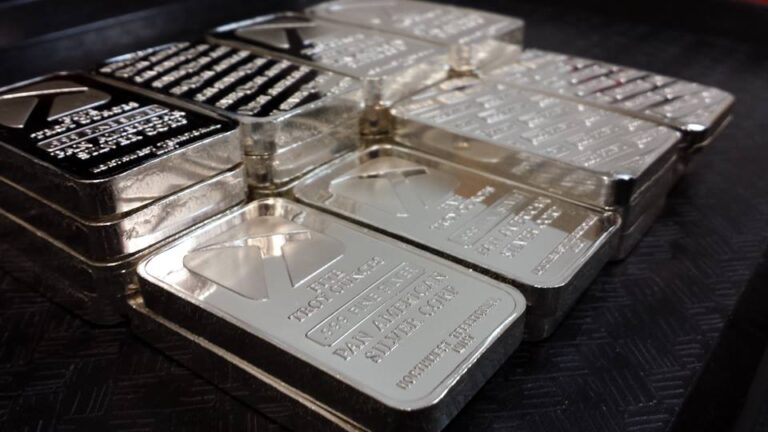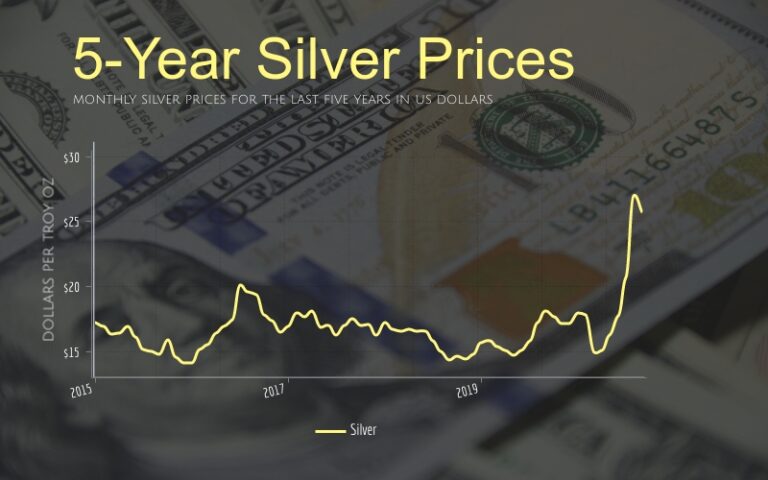Live Silver Price Per Ounce

Silver is a precious metal that has been used for centuries both as an investment and in industry. The price of silver per ounce is closely monitored by traders, investors, and industrialists alike due to its fluctuating value.
This article will discuss the factors that influence silver prices, how to track live silver prices, what the value of silver is relative to other currencies, how to invest in silver, and what silver futures are.
What Influences Silver Prices?
Understanding the factors that impact the cost of silver is essential for making informed decisions in relation to investments. The price of silver is affected by a variety of macroeconomic and geopolitical forces, such as interest rates, economic growth, currency markets, supply and demand dynamics, inflationary pressures, and investment flows. These factors all have an effect on how much it costs to buy an ounce of silver.
The price can also be impacted by industrial demand for silver products such as solar panels or electronic devices. Additionally, speculation plays a role in short-term fluctuations since investors may buy large amounts when they expect prices to rise.
As the global economy fluctuates due to these various influences, so too does the cost of silver per ounce. Silver is also vulnerable to crises such as wars or natural disasters which can disrupt production or cause investor panic resulting in sharp increases in prices.
Government policies and regulations set limits on production and trading activities which can affect the availability of silver on international markets. Moreover, commodities traders manipulate prices through futures contracts which allow them to speculate on future market movements without actually buying physical metal.
All these aspects contribute to determining live silver prices per ounce over time and should be taken into account when considering investing in this precious metal.
How to Track Live Silver Prices?
Tracking the current value of silver is a necessary step in making informed decisions related to investment. Fortunately, there are numerous websites and resources available that make it easy to stay abreast of live silver prices.
Popular sources for tracking the price of silver include commodity exchange websites, such as COMEX or NYMEX, which provide live futures market quotes for traders and investors. These exchanges also offer historical data so users can track trends over time.
Additionally, some independent financial websites offer live streaming quotes and charts for various commodities including silver. Many news outlets also have dedicated sections on their websites with up-to-date information on the price of precious metals like gold and silver.
Lastly, many online stock brokers now allow users to view real-time prices for various commodities directly from their trading platforms.
How to Calculate the Value of Silver?
Calculating the value of silver requires taking into account factors such as market demand, production costs, and other economic indicators. To accurately calculate the value of silver, one must consider the following:
- The current market price for silver – This is determined by supply and demand in the global markets and can fluctuate significantly over short periods of time.
- Production costs – Any hidden costs that are associated with producing or acquiring silver should be taken into consideration when estimating the value of a particular item made from it.
- Economic indicators – Factors such as inflation, currency exchange rates, and interest rates can all affect the cost of goods made using silver.
- Quality – The purity level of individual pieces or lots of silver determines its current worth on the open market as higher quality items command a premium compared to lower quality versions with more impurities present.
By considering all these factors when determining the value of any given piece or lot of silver, investors and collectors alike can ensure they are getting an accurate assessment for their money when buying or selling this precious metal commodity.
How to Invest in Silver?
Investing in silver is a great way to diversify one’s portfolio and gain exposure to the potential benefits of this precious metal commodity. Silver has many uses and investment opportunities, ranging from coins, bullion bars, ETFs, futures contracts, mining stocks and more. Investing in silver can be an attractive option for those looking for a hedge against inflation or a safe-haven asset during times of market volatility.
When it comes to investing in silver there are different types of investments available that may suit individual needs or preferences. The most common type of silver investment is physical silver such as coins and bullion bars. These are tangible items that investors can hold onto if they wish. Another form of investing in silver is by buying Exchange Traded Funds (ETFs) which are funds traded on stock exchanges that track the price movements of the underlying assets such as gold or silver prices. Futures contracts allow investors to speculate on future price movements without actually owning any physical metals, but still having exposure to the spot prices through derivatives trading. Additionally, investors can also purchase shares in mining companies which provide exposure to the profits generated from extracting and selling minerals like gold and silver on world markets.
| Type | Advantages | Disadvantages |
|---|---|---|
| Physical Silver | Tangible item Hedge against inflation Safe-haven asset Option for long-term holding | Premium pricing Storage costs Liquidity risk |
| ETFs | Low cost Easy access Can be sold short Diversification options | Market risks associated with leveraged ETFs Counterparty risks Tracking errors due to diverging index performance |
| Futures Contracts | Leverage opportunities Ability to go short & long easily Ability to hedge positions | Ability to go short and long easily |
| Mine Stocks | Leverage potential gains from rising metal prices Diversified portfolio exposures | Diversified portfolio exposures |
What are Silver Futures?
Silver futures provide investors with an opportunity to speculate on the future price movements of this precious metal commodity without actually owning any physical silver.
Silver futures are contracts that allow buyers and sellers to agree upon a price today for delivery of silver at a predetermined date in the future.
The buyer is obligated to buy the silver at the agreed-upon price, while the seller is obligated to deliver it.
This contract may be used as a hedge against uncertain market conditions, or as an investment instrument for speculators who seek to profit from short-term fluctuations in commodity prices.
Silver futures can be traded through a range of brokers and exchanges worldwide.
Investors must have sufficient capital to open an account with these entities and satisfy margin requirements, which involve putting up collateral in order to guarantee performance on their trading accounts.
Contracts typically involve payment of fees such as commissions, clearing fees, exchange fees, and other related charges that might affect overall profitability when trading silver futures.
Frequently Asked Questions
What is the historical price of silver?
The historical price of silver has been highly volatile over the years, with prices ranging from as low as $4.17 per ounce in August 1993 to a high of $48.58 per ounce in April 2011.
The average price of silver for 2018 was at its highest since 2014, rising to an average of $14.99 per ounce due to factors such as increased demand from investors and industrial users.
In 2019, the average price decreased slightly but remained above the long-term trend line, reaching an average of $15.05 per ounce by December 2019.
What is the difference between spot and futures price of silver?
The spot price and futures price of silver are two distinct concepts that are used in the trading of this precious metal.
The spot price is the current market price for a commodity, while the futures price is an agreement to buy or sell a certain amount of a commodity at an agreed-upon date in the future.
Spot prices can be volatile due to supply and demand; meanwhile, future contracts provide more stability as they set out terms ahead of time.
As such, investors often use both approaches when trading silver, depending on whether they want to take advantage of changing market conditions or secure a particular pricing level for their assets.
How can I safely store physical silver?
Silver is a precious metal that has historically been used as an investment and store of value.
When investing in physical silver, it is important to consider the most secure methods for storing your investments.
The best way to store physical silver is by using a depository or vault service.
These services provide storage in either individual safe deposit boxes or larger vaults, depending on the size and type of silver being stored.
Depositories typically also offer insurance policies that cover any loss or theft of the stored assets.
Additionally, some private companies may offer customers their own personal safes for use at home with adequate security measures taken such as locks with keypads and other features to ensure the safety of your valuable assets.
What are the advantages of investing in silver?
Investing in silver has long been the choice of savvy investors due to an unparalleled array of advantages. Silver is more affordable than other precious metals such as gold, platinum, and palladium.
It also offers a higher liquidity rate than other physical commodities like art or antiques. Silver can be held for both short-term and long-term investment purposes, with its price potential rising significantly over time.
Moreover, silver is seen as a hedge against inflation since it generally retains its value during economic downturns and recessions. Its relatively low volatility compared to other investments makes it an attractive option for portfolio diversification.
How do I buy silver bullion?
Buying silver bullion is a popular way to invest in the precious metal for both experienced and novice investors. When buying silver bullion, there are several factors to consider including the type of bullion, the condition of the coins, and where to buy from.
Silver bullion comes in various forms such as coins, bars, or rounds. Coins are typically produced by government mints while bars and rounds are usually manufactured by private companies.
The condition of silver bullion is important when considering value since it affects its grade and therefore its worth as an investment piece. Lastly, buyers should research reputable dealers who offer competitive prices before purchasing silver bullion.
Conclusion
Investigating the theory that silver is a good investment for those looking to diversify their portfolios, evidence suggests that silver prices can be volatile but are influenced by many factors.
These include macroeconomic events and trends in industrial production.
Tracking live silver prices is essential for investors to stay up-to-date on the market and to calculate the value of their investment.
Silver futures provide an alternative way of investing in the metal, allowing traders to speculate on price movements without actually taking ownership of any physical assets.
Overall, it appears that silver can be a lucrative option for investors looking to diversify their portfolio or hedge against other investments.






